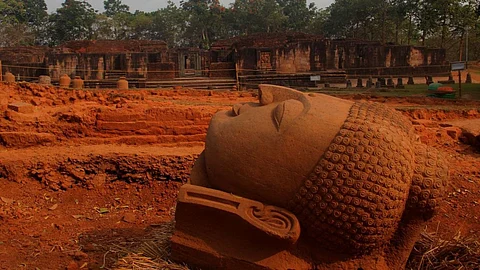
- HOMEGROWN WORLD
- #HGCREATORS
- #HGEXPLORE
- #HGVOICES
- #HGSHOP
- CAREERS
- ABOUT US
- CONTACT US

For almost three years between 1958 and 1961, the late archaeologist Debala Mitra — the first woman to head the Archaeological Survey of India — oversaw excavations at a little-known village called Ratnagiri in the Jajpur district of Odisha. Although the site was first discovered in 1905, the 1958-1961 excavations were the first systemic explorations conducted at the site. The dig unveiled two magnificent monasteries, a large stupa, a cluster of shrines and many sculptures — the remains of a remarkable Buddhist complex which flourished between the 5th and 13th centuries AD.
Now, almost six decades later, Ratnagiri is making headlines once again. Recent excavations at Ratnagiri have revealed three colossal Buddha heads, hundreds of votive stupas, stone inscriptions, and images of Tantric Buddhist gods and goddesses.
These significant discoveries were made by a team of 50 archaeologists, students, and labourers who have been working under the Archaeological Survey of India at Ratnagiri since December 2024. Over the last two and a half months, the team has unearthed several archaeological artefacts including three colossal heads of the Buddha made from khondolite stone, the largest of which measures 1.4 metres in height. It may be the largest one ever found in Odisha.
Ratnagiri — which means 'Hill of Jewels' in Odia — along with Udayagiri and Lalitgiri, form the 'Diamond Triangle' of three coeval Buddhist sites located within a 314 square kilometre area in Odisha. Ratnagiri is located on top of a mound in the Assia hill range in Jajpur and encircled by the rivers Brahmani, Kimiria, Birupa, and their tributaries.
Archaeologists believe this location was selected strategically for a Buddhist monastic settlement as its secluded nature in the 5th century made it ideal for esoteric spiritual and scholarly pursuits. The monastery at Ratnagiri — known as 'Sri Ratnagiri Mahavihara Arya Bhikshu Sangha' according to seals found at the site — likely peaked between 9th and 10th centuries CE under the royal patronage of the Bhaumakara dynasty.
According to archaeologists, Ratnagiri was a centre of Vajrayana or Tantric Buddhism in India. It is believed that Buddhist missionaries from Ratnagiri took Vajrayana Buddhism to Java and Tibet circa 10th century CE. In fact, the Ratnagiri monastery may even have rivalled the much better known Nalanda during its prime. But as Buddhism declined and the Bhakti movements led to the revival of Hinduism across India between 6th and 12th centuries CE, the mahaviharas or great monasteries also faded over time. Dwindling royal patronage, the mismanagement of land endowments, internal conflicts within the monastic orders, backlash from the Hindu orthodoxy, changes in people's religious beliefs, and ultimately the iconoclastic Islamic conquest circa 12th century CE led to a near-total eradication of Buddhism within India.
The Archaeological Survey of India will continue excavations in Ratnagiri till the end of March when the harsh summer sun makes it difficult to work outdoors. As archaeologists continue to examine and analyse these new findings, we should learn more about the murky history of late Buddhism and its slow decline when monasteries were abandoned, statues were defaced, and entire monastic complexes — like Ratnagiri — were quite literally buried underground.
If you enjoyed reading this, here's more from Homegrown:
India’s Most Fascinating Archaeological Discoveries
A Lost Civilization Was Just Discovered At Vangchhia In Mizoram
A 10,500-Year-Old Camping Site Was Excavated In Ladakh By Archaeological Survey Of India
